新视野大学英语读写教程2-1单元课件PPT
- 格式:ppt
- 大小:6.06 MB
- 文档页数:13
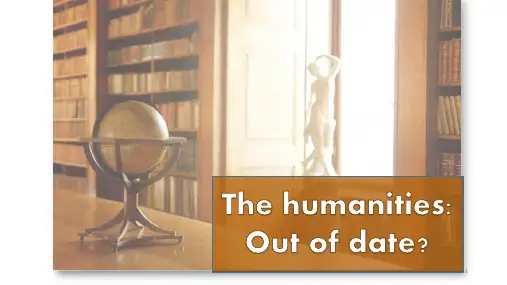
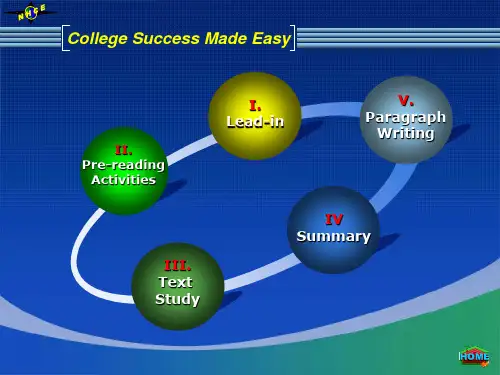
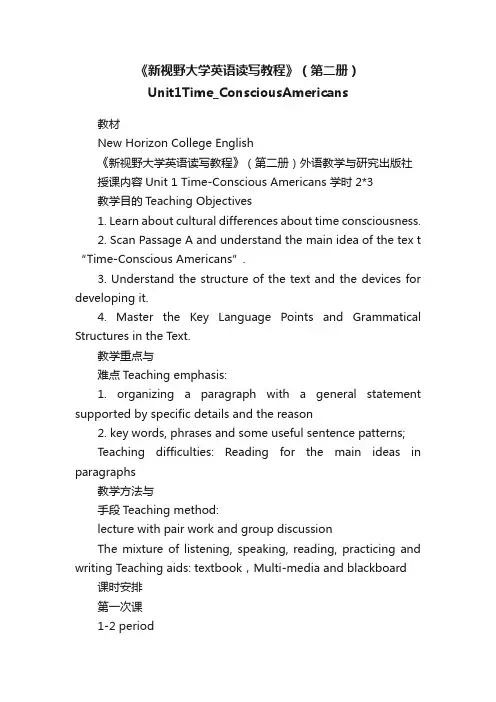
《新视野大学英语读写教程》(第二册)Unit1Time_ConsciousAmericans教材New Horizon College English《新视野大学英语读写教程》(第二册)外语教学与研究出版社授课内容Unit 1 Time-Conscious Americans 学时2*3教学目的Teaching Objectives1. Learn about cultural differences about time consciousness.2. Scan Passage A and understand the main idea of the tex t “Time-Conscious Americans”.3. Understand the structure of the text and the devices for developing it.4. Master the Key Language Points and Grammatical Structures in the T ext.教学重点与难点Teaching emphasis:1. organizing a paragraph with a general statement supported by specific details and the reason2. key words, phrases and some useful sentence patterns;Teaching difficulties: Reading for the main ideas in paragraphs教学方法与手段Teaching method:lecture with pair work and group discussionThe mixture of listening, speaking, reading, practicing and writing Teaching aids: textbook,Multi-media and blackboard 课时安排第一次课1-2 periodⅠWarm-up Activity1.Group work 15m2.Questions for thought and discussion 15mⅡBackground Information 10mⅢ listening 25mⅣ watch and Answer 25m第二次课3-4 periodⅤText Analysis·Global Reading 25m1. Main idea2. Text structure·Detailed Reading 65mWordsPhrasesLanguage points第三次课5-6 periodLanguage points 15mⅥText Summary 5mⅦWriting 25mⅧExercise Explanation 45m教学要点Teaching Points:1. Let the Ss know the learning objectives of this unit;2. Help the Ss understand the text as a whole and know some background knowledge;3. Have the Ss know some ideas of fame;4. Guide the Ss use freely the active expressions, key grammatical points and sentence patterns in this text.作业布置与思考Assignments:1. Vocabulary: Students are asked to master the key words and phrases.2. Sentence Structure: Teacher summaries the usage of “either…or” and “where” and Studentspractice rewriting sentences after the models.3. Translation教学参考书和网络资源Reference Books and Resources:1. Teacher’s Book of New Horizon College English2. Longman Dictionary of Contemporary English (English-Chinese)3. Oxford Advanced Learner’s English-Chinese Dictionary4. Longman Dictionary of American English5. On-line resources: English on line教学过程1-2 PeriodⅠWarm-up Activity (提问板书)1. Group work:1) Find out idioms Chinese have about time.Time is money.(时间就是金钱或一寸光阴一寸金)Time and tide wait for no man.(岁月不待人)Never put off till tomorrow what may be done today.(今日事,今日毕)2) Find out major differences of time between Chinese and English culture.Chinese Culture:a)masses (collectivism).b)human and 'heaven' as one (天人和一).c)ethics and tolerance (中恕之道).d)internal cultivation (修身养性).Western culture:a)Individualism.b)adventurous and exploration based.c)based on scienced)law to resolve people and people's relationship.e)'god' and religion to resolve human and spiritualism relationship.2. Questions for thought and discussion:(提问课本)1)What precious resources do Americans value and save?2)What are the three kinds of behavior that Americans consider to be a waste of time?3)In what different ways do Americans approach time in business relations?Ⅱ Background Information: (讲解课件)1. Cultural Conflicts:Each nation has its own conventions. Different nations have different cultures. When two cultures clash, problems in communication may occur. Which side should compromise when there are cultural conflicts? In fact, knowing and understanding the other's culture is the responsibility of both sides, and both sides should be willing to compromise. Educating, rather than complaining and blaming, is the best solution to cultural conflicts.2. Hourglass:A glass container holding fine sand for measuring time, which is narrow in themiddle like a figure 8 so that the sand inside can run slowly from the top half to the bottom taking exactly one hour.。
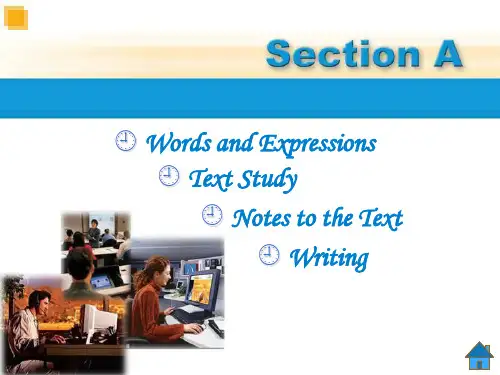
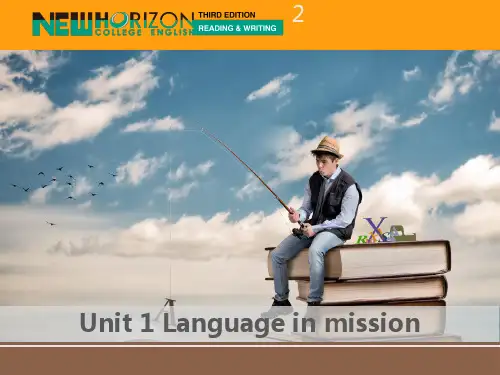
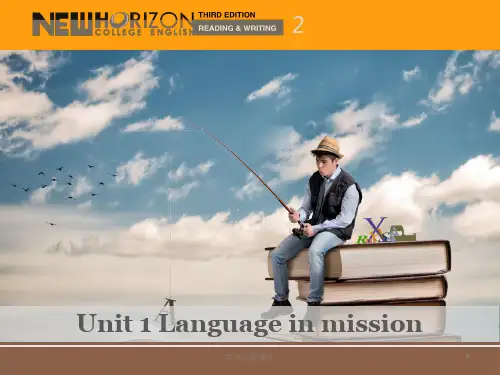
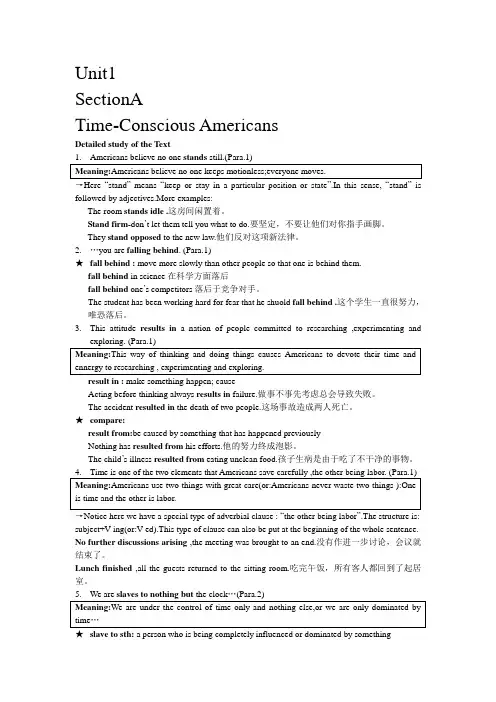
Unit1SectionATime-Conscious AmericansDetailed study of the T extfollowed by adjectives.More examples:The room stands idle .这房间闲置着。
Stand firm-don’t let them tell you what to do.要坚定,不要让他们对你指手画脚。
They stand opposed to the new law.他们反对这项新法律。
2.…you are falling behind. (Para.1)★fall behind : move more slowly than other people so that one is behind them.fall behind in science在科学方面落后fall behind one’s competitors落后于竞争对手。
The student has been working hard for fear that he shuold fall behind .这个学生一直很努力,唯恐落后。
3.This attitude results in a nation of people committed to researching ,experimenting andresult in : make something happen; causeActing before thinking always results in failure.做事不事先考虑总会导致失败。
The accident resulted in the death of two people.这场事故造成两人死亡。
★compare:result from:be caused by something that has happened previouslyNothing has resulted from his efforts.他的努力终成泡影。
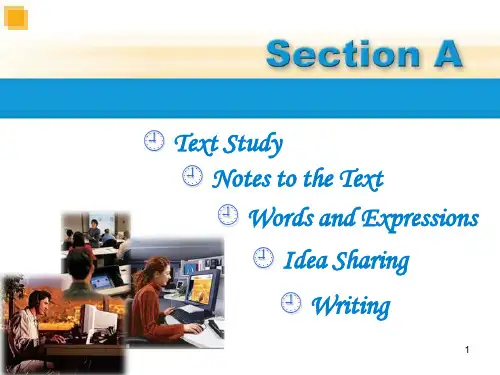
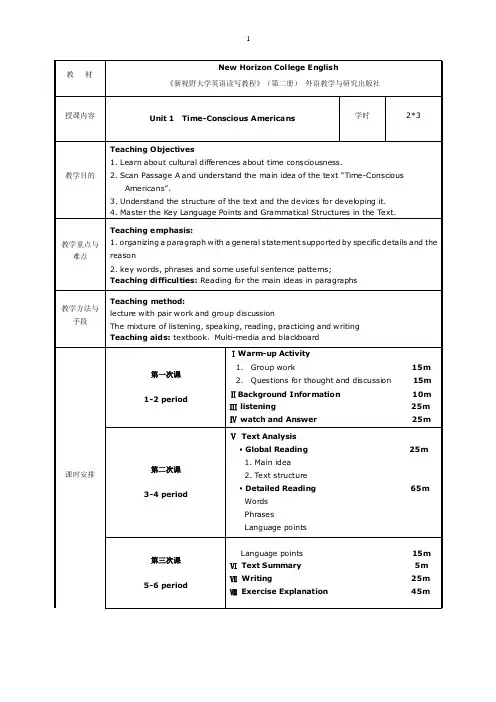
教材New Horizon College English《新视野大学英语读写教程》(第二册)外语教学与研究出版社授课内容Unit 1 Time-Conscious Americans 学时2*3教学目的Teaching Objectives1. Learn about cultural differences about time consciousness.2. Scan Passage A and understand the main idea of the tex t “Time-ConsciousAmericans”.3. Understand the structure of the text and the devices for developing it.4. Master the Key Language Points and Grammatical Structures in the Text.教学重点与难点Teaching emphasis:1. organizing a paragraph with a general statement supported by specific details and the reason2. key words, phrases and some useful sentence patterns;Teaching difficulties: Reading for the main ideas in paragraphs教学方法与手段Teaching method:lecture with pair work and group discussionThe mixture of listening, speaking, reading, practicing and writing Teaching aids: textbook,Multi-media and blackboard课时安排第一次课1-2 periodⅠWarm-up Activity1.Group work 15m2.Questions for thought and discussion 15mⅡBackground Information 10mⅢ listening 25mⅣ watch and Answer 25m第二次课3-4 periodⅤText Analysis·Global Reading 25m1. Main idea2. Text structure·Detailed Reading 65mWordsPhrasesLanguage points第三次课5-6 periodLanguage points 15mⅥText Summary 5mⅦWriting 25mⅧExercise Explanation 45m教学要点Teaching Points:1. Let the Ss know the learning objectives of this unit;2. Help the Ss understand the text as a whole and know som e background knowledge;3. Have the Ss know some ideas of fam e;4. Guide the Ss use freely the active expressions, key grammatical points and sentence patterns in this text.作业布置与思考Assignments:1. Vocabulary: Students are asked to master the key words and phrases.2. Sentence Structure: Teacher summaries the usage of “either…or” and “where”and Students practice rewriting sentences after the models.3. Translation教学参考书和网络资源Reference Books and Resources:1. Teacher’s Book of New Horizon College English2. Longman Dictionary of Contemporary English (English-Chinese)3. Oxford Advanced Learner’s English-Chinese Dictionary4. Longman Dictionary of American English5. On-line resources: English on line教学过程1-2 PeriodⅠWarm-up Activity (提问板书)1. Group work:1) Find out idioms Chinese have about time.Time is money.(时间就是金钱或一寸光阴一寸金)Time and tide wait for no man.(岁月不待人)Never put off till tomorrow what may be done today.(今日事,今日毕)2) Find out major differences of time between Chinese and English culture.Chinese Culture:a)masses (collectivism).b)human and 'heaven' as one (天人和一).c)ethics and tolerance (中恕之道).d)internal cultivation (修身养性).Western culture:a)Individualism.b)adventurous and exploration based.c)based on scienced)law to resolve people and people's relationship.e)'god' and religion to resolve human and spiritualism relationship.2. Questions for thought and discussion:(提问课本)1)What precious resources do Americans value and save?2)What are the three kinds of behavior that Americans consider to be a waste oftime?3)In what different ways do Americans approach time in business relations?Ⅱ Background Information: (讲解课件)1. Cultural Conflicts:Each nation has its own conventions. Different nations have different cultures. When two cultures clash, problems in communication may occur. Which side should compromise when there are cultural conflicts? In fact, knowing and understanding the other's culture is the responsibility of both sides, and both sides should be willing to compromise. Educating, rather than complaining and blaming, is the best solution to cultural conflicts.2. Hourglass:A glass container holding fine sand for measuring time, which is narrow in the middle like a figure 8 so that the sand inside can run slowly from the top half to the bottom taking exactly one hour.。

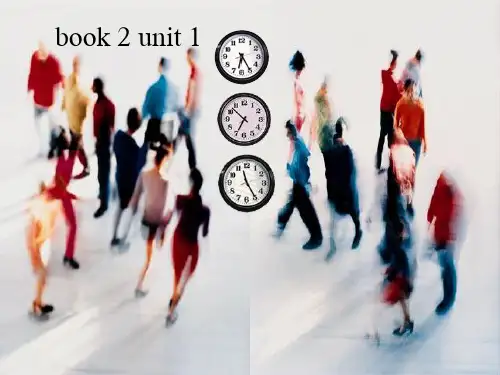
新视野大学英语读写2第三版B2U2PPT PPT概述本PPT是针对新视野大学英语读写2第三版教材中的B2U2单元所制作的。
该单元主要讲解了如何进行有效的听力训练和提高阅读理解能力。
本PPT旨在通过图文并茂的方式,为学生提供简洁明了、易于理解的学习资料,帮助他们更好地掌握这一单元的知识要点。
PPT结构本PPT共分为以下几个部分: 1. Unit Introduction 介绍本单元的学习目标和重点; 2. Listening Skills 听力技巧,包括如何提高听力的方法和技巧; 3. Listening Practice 听力练习,提供几个与本单元相关的听力练习题目; 4. Reading Skills 阅读技巧,讲解如何有效提高阅读理解能力; 5. Reading Practice 阅读练习,给出一篇与本单元相关的阅读材料,并提供相关的问题以加深对内容的理解; 6. Summary 总结本单元的核心要点,强化学生对知识的记忆和理解; 7. References 提供参考资料和链接,供学生进一步学习和了解本单元相关的内容。
Unit Introduction在本部分,PPT将首先介绍本单元的学习目标和重点,以让学生对本单元的学习内容有一个整体的了解。
主要包括以下内容: - 本单元的主题和话题; - 本单元的学习目标,包括提高听力和阅读理解能力; - 本单元的学习重点,包括听力技巧和阅读技巧。
Listening Skills在本部分,PPT将介绍一些实用的听力技巧,帮助学生提高他们的听力能力。
主要包括以下几个方面: - 如何提高听力的注意力和集中力,包括减少干扰和专注于重点; - 如何通过积累词汇和短语来提高听力能力,包括背诵和听力训练; - 如何通过多听和多练来提高听力技巧,包括听BBC新闻、英语电台等。
Listening Practice在本部分,PPT将提供几个与本单元相关的听力练习题目,帮助学生巩固所学知识,并提高他们的听力理解能力。
Unit 2: The Language of Advertising Part 1: Pre-reading Activities1. BrainstormingBefore reading the passage, it's helpful to brainstorm some ideas related to advertising. You can ask yourself: what do you think of when you hear the word "advertising"? What advertisements do you remember seeing recently? What makes an advertisement effective? What are some common advertising techniques? Jot down your ideas andshare with a partner or group.2. Vocabulary PreviewPreviewing the vocabulary in the passage can help you understand the text better. Look at the bolded words in the passage and try to guess their meanings based on context. You can also use a dictionary to check your guesses.Part 2: Reading and Comprehension Check1. SkimmingSkim through the passage quickly to get an overall idea of the topic and main points. Pay attention to headings, subheadings, and any bolded or italicized words.2. ScanningScan the passage for specific information. For example, you can look for answers to the following questions: What is the purpose of advertising? What are some common advertisingtechniques? What are some criticisms of advertising?3. Close ReadingRead the passage carefully, paying attention to details and nuances. Take notes on the main points and any supporting details. You can also highlight or underline important information.4. Comprehension CheckAfter reading the passage, check yourcomprehension by answering some questions. You can use the questions provided in the textbook or come up with your own. Make sure you understand the main ideas and can explain them in your own words.Part 3: Vocabulary Expansion1. Word FormationLook at the vocabulary words in the passage and try to identify their word forms (e.g. noun, verb, adjective, adverb). Then, try to come up with other forms ofthe same word. For example, if the word is "advertising," you can also have "advertise" (verb), "advertisement" (noun), and "advertiser" (noun).2. Synonyms and AntonymsLook for synonyms and antonyms of the vocabulary words in the passage. This can help you expand your vocabulary and understand the meanings of the words in different contexts.3. Contextual CluesPay attention to the context in which the vocabulary words are used. This can give you clues about their meanings. Also, look for any examples or illustrations that help explain the meaning of the word.Part 4: Writing Practice1. SummarizingSummarize the main points of the passage in your own words. Try to condense the information into a few sentences or bullet points.2. RespondingWrite a response to the passage. You can express your opinion about the topic, provide examples from your own experience, or ask questions for further discussion.3. ApplyingApply the information from the passage to a real-life situation. For example, you can analyze an advertisement you saw recently and identify the techniquesused, or write your own advertisement using some of the techniques discussed in the passage.。